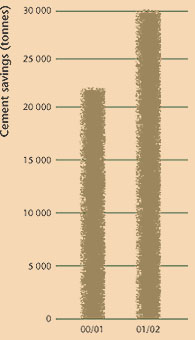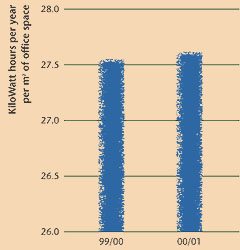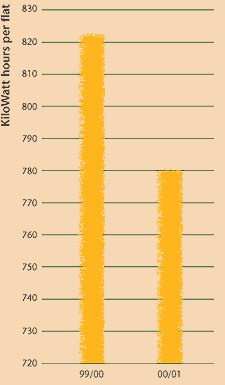 |
Timber
Savings by Construction Practice (tonnes)
Text-only
version
 |
Last
year we saved at least 33 000 tonnes of timber by using alternative
construction practices. |
Tropical
Hardwood
We have been using reusable metal hoardings, metal formwork and prefabricated
building components to reduce the use of timber in the construction
of our housing blocks. Up to 1999, it was estimated that more than
929 000 tonnes of timber have been saved. Last year we saved at least
another 33 000 tonnes. At the same time, we are also investigating
the use of timber from suitably accredited sustainable sources. In
the meantime we continue to make every effort to reduce our use of
timber.
Use of Recycled Materials in Conserving Resources
We already use Pulverised Fuel Ash (PFA) as a partial cement substitute
in a variety of uses. We have investigated and found we can increase
the amount used. This has two benefits. We use less cement thereby
saving large amounts of energy in its production at quarries. Also
we utilise a waste product from another industry (PFA is a by product
of power generation).
We also intend to increase the use of recycled crushed aggregates
(mainly from demolition works), because use of recycled aggregates
reduces the demand for freshly quarried materials. We use recycled
crushed aggregates in drainage and earthworks and are awaiting the
results of a trial by Works Department on use of recycled aggregates
in concrete.
Actual and Forecast Cement Savings through
PFA Substitution
Text-only version
 |
We
aim to minimise resource use and minimise the impact of resource
extraction. |
Energy
Efficiency Registration Scheme
We are actively
participating in the Hong Kong Energy Efficiency Registration
Scheme for Buildings. In 2000, in addition to New Harmony 1,
the New Harmony Annex 5 Block was successfully certified for
compliance with the Code of Practice for Energy Efficiency of
Lighting Installation. The adoption of the new lighting design
in New Harmony Blocks has resulted in an estimated electricity
saving of HK$0.3M per year for the domestic blocks tendered
in 2000/2001. |
Energy
Conservation & Energy Efficiency
Energy efficiency is a key element of our energy management strategy
which seeks to minimise energy usage in the communal areas of HA properties.
The Energy fficiency Committee:
 |
Conducts
regular monitoring of electricity consumption to avoid unnecessary
power consumption. |
 |
Monitors
electricity accounts to minimise electricity charges. |
 |
Identifies
energy saving opportunities. |
Past initiatives
to use energy efficiently, which we will continue to implement in
new projects, include use of energy saving lamps and energy-efficient
floodlights in car parks, adoption of automatic timer control systems,
replacing less efficient lift drive systems, optimising energy use
in air conditioning systems and water pumps, and introducing thermal
efficient measures in window designs for Harmony and Concord Block
types.
We will continue to work on the following:
 |
We
are now adopting higher lighting output (2 x 24W) compact fluorescent
lamps which will reduce the number of lamps in corridors by
40%. |
 |
Tests
are being carried out on the use of more efficient electronic
ballasts in fluorescent luminaries on their reliability, energy
performance and suitability for hot and humid climate conditions.
Electronic ballasts were fitted in 5 car parks last year. |
 |
Following
a pilot trial, photocell lighting control will be installed
next year in 16 estates. |
 |
We
have successfully registered two shopping centre developments
under the Hong Kong Energy Efficiency Registration Scheme for
Buildings; one centre in compliance with the Energy Codes for
lighting, A/C and electrical installation, and the other in
compliance with the Codes for lighting and A/C. |
Electricity
Usage in Common Areas in Public Housing Estates
Text-only
version
|
 |
Annual
HA Office Electricity Usage
Text-only
version |
 |
| Electricity
usage in our offices (per office area) remained about
the same as last year. It increased by 0.23%. We incurred
higher energy usage as we had to fit out our new extension
building at our Headquarters before our staff occupied
it in January 2001. |
|
 |
| We
are reducing electricty consumption in common areas in public
housing estates. Last year, this saved HK$36M. |
|
 |

